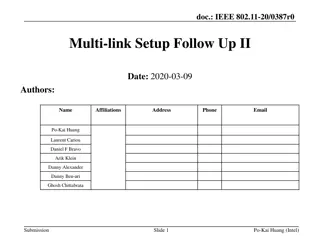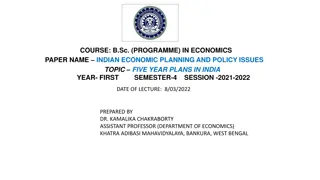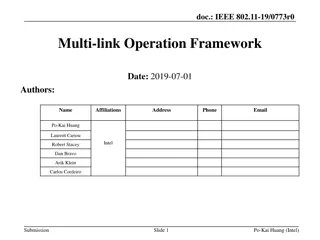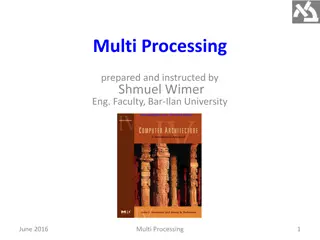Evolution of Multi-Level Planning in India
Explore the historical background and stages of multi-level planning in India, from the national level to the grassroots Panchayat level. Learn about the transition from the Planning Commission to NITI Aayog at the national level and the crucial role of state Planning Boards in coordinating development plans. Discover the journey towards decentralized and balanced regional development through a bottom-up approach.
Download Presentation

Please find below an Image/Link to download the presentation.
The content on the website is provided AS IS for your information and personal use only. It may not be sold, licensed, or shared on other websites without obtaining consent from the author. Download presentation by click this link. If you encounter any issues during the download, it is possible that the publisher has removed the file from their server.
E N D
Presentation Transcript
MULTI LEVEL PLANNING IN INDIA MA SEM I & III GEOGRAPHY
Bottom up approach Decentralised Balanced regional development
Historical background of MLP Community development programme 1 st and 2nd FYP Balwant Rai Mehta (1957) 3 tier Panchayati Raj Dantewala working group (1978) Block level Planning Ashok Mehta Committee (1977) - strengthening of planning at Zila Parishad level by placing district level officers under DRDA Hanumantha Rao Committee (1982) -principle of sharing of resources Sarkaria Commission (1985) - setting up of state finance commission to transfer resources to districts. 73rd amendment act (1992) - PRIs attained constitutional status
Stages of multi-level planning in India 1. National Level - inter-state / inter-regional planning. 2. State Level - inter-district / inter-regional planning. 3. District/Metropolitan Level - regional planning. 4. Block Level - area planning 5. Panchayat Level - village planning.
National Level Upto 2014: Planning Commission National Development Council PC has been granted constitutional status through 52nd Amendment of the Constitution The Commission formulates three types of plans: (a) Perspective plans for 15-25 years, (b) Five year plans, and (c) Annual plans within the framework of Five Year Plan.
After 2014: PC was replaced by NITI Aayog. The 12th Plan, the last of the Five-Year Plans, was ended on 31st March, 2017. Now, three-year action plan, which will be part of a seven-year strategy paper and a 15-year vision document. The Niti Aayog is launching a three-year action plan from April 1, 2017.
State level The state Planning Board acts like national Planning Commission and coordinates the development plans. It also has the responsibility of the formulation, implementation and monitoring of state plan. States enjoy autonomy in certain state subjects and play pivotal role in the implementation of planning programmes. State level that all sorts of economic and social data are available. There is a need for more rigorous exercise of planning at state-level.
District Level local level planning success of the planning needs greater mobilization and utilization of local resources The District Board consists of elected representatives Presently District Planning is supervised through Zila Parishad and its Chairman. Its formulation and implementation are looked after by the District Planning Officer (DPO) or the District Magistrate.
Block Level: Block is an important unit of micro-level planning. The general supervision of blocks was made by the Block Samiti or Panchayat Samiti under the chairmanship of the Block Pramukh or Sabhapati and elected representatives. The main objective of this planning was to absorb local labour surpluses and greater involvement of people in the formulation and implementation of development plans.
The relevance of block-level planning is based on - the viable areal and population-size, - more of to the regional and local problems, - easier identification of target groups, - optimum utilization of regional/local resources, and - greater participation of people in plan formulation and implementation
Block Level planning involves the development of agriculture, irrigation (mainly minor irrigation), soil conservation, animal husbandry, pisciculture, forestry, minor processing of agricultural products, small and cottage industries, creation of local-level infra-structure, and development of social services like water supply, health, education, shelter, sanitation, local transport, and welfare plans.
Panchayat-Level The implementation of the plan at the Panchayat-level is the responsibility of the village development officer (VDO) and the secretary and is supervised by the Gram Sabha which is headed by the Gram Pradhan. Under the existing provisions, funds for the Gram Sabha (Village Panchayat) are directly being allocated from the centre to execute rural development programmes.
Panchayat has also been entrusted with following responsibility the promotion of agriculture, rural industries, provision of medical relief, maternity, women and child welfare, maintaining common grazing grounds, village roads, tanks, wells, sanitation and execution of other socio-economic programmes. In some places, they are also authorized to supervise primary education and collect land revenue























